Cement Mortars Based on Polyamide Waste Modified with Fly Ash from Biomass Combustion—A New Material for Sustainable Construction
Abstract
:1. Introduction
2. Materials and Methods
2.1. Waste Characteristics
2.2. Preparation of Cement Mortars
2.3. Research Methods
3. Results and Discussion
3.1. Mechanical Strength of Mortars Containing Waste
3.2. Water Absorption of Mortars Modified with Waste
3.3. Frost Resistance of Mortars Modified with Waste
3.4. Leaching of Metal Ions from Mortars Modified with Waste
3.5. Microstructure of Cement Mortars Modified with Waste
3.6. Economic and Ecological Effectiveness of Using Waste Modifications
4. Conclusions
Author Contributions
Funding
Institutional Review Board Statement
Informed Consent Statement
Data Availability Statement
Conflicts of Interest
References
- Odzijewicz, J.I.; Wołejko, E.; Wydro, U.; Wasil, M.; Jabłońska-Trypuć, A. Utilization of Ashes from Biomass Combustion. Energies 2022, 15, 9653. [Google Scholar] [CrossRef]
- Vassilev, S.V.; Baxter, D.; Andersen, L.K.; Vassileva, C.G. An Overview of the Composition and Application of Biomass Ash. Part 1. Phase—Mineral and Chemical Composition and Classification. Fuel 2013, 105, 40–76. [Google Scholar] [CrossRef]
- Vassilev, S.V.; Baxter, D.; Andersen, L.K.; Vassileva, C.G. An overview of the chemical composition of biomass. Fuel 2010, 89, 913–9333. [Google Scholar] [CrossRef]
- Wang, K.; Tester, J.W. Sustainable management of unavoidable biomass wastes. Green Energy Resour. 2023, 1, 100005. [Google Scholar] [CrossRef]
- Jura, J.; Ulewicz, M. Assessment of the Possibility of Using Fly Ash from Biomass Combustion for Concrete. Materials 2021, 14, 6708. [Google Scholar] [CrossRef] [PubMed]
- Sá, J.C.; Carvalho, A.; Fonseca, L.; Santos, G.; Dinis-Carvalho, J. Science Based Targets and the factors contributing to the sustainable development of an organisation from a Literature review to a conceptual model. Prod. Eng. Arch. 2023, 29, 241–253. [Google Scholar] [CrossRef]
- Tomov, M.; Velkoska, C. Contribution of the quality costs to sustainable development. Prod. Eng. Arch. 2022, 28, 164–171. [Google Scholar] [CrossRef]
- Jacobson, S.; Högbom, L.; Ring, E.; Nohrested, H.Ö. Effects of Wood Ash Dose and Formulation on Soil Chemistry at Two Coniferous Forest Sites. Water Air Soil Poll. 2004, 158, 113–125. [Google Scholar] [CrossRef]
- Zhai, J.; Burke, I.T.; Stewart, D.I. Beneficial management of biomass combustion ashes. Renew. Sustain. Energy Rev. 2021, 151, 111555. [Google Scholar] [CrossRef]
- Li, Y.; Liang, G.; Chang, L.; Zi, C.; Zhang, Y.; Peng, Z.; Zhao, W. Conversion of biomass ash to different types of zeolites: A review. Energy Sources Part A Recovery Util. Environ. Eff. 2021, 43, 1745–1758. [Google Scholar] [CrossRef]
- Belviso, C. State-of-the-art applications of fly ash from coal and biomass: A focus on zeolite synthesis processes and issues. Prog. Energy Combust. Sci. 2018, 65, 109–135. [Google Scholar] [CrossRef]
- Alyosef, A.H.; Roggendorf, D.H.; Schneider, A.; Inayat, J.; Welscher, W.; Schwieger, T.; Münster, G.; Kloess, S.; Ibrahim, S.; Enke, D. Comparative study between direct and pseudomorphic transformation of rice husk ash into MFI-type zeolite. Molecules 2018, 23, 1. [Google Scholar] [CrossRef] [PubMed]
- Fukasawa, T.; Horigome, A.; Karisma, A.D.; Maeda, N.; Huang, A.N.; Fukui, K. Utilization of incineration fly ash from biomass power plants for zeolite synthesis from coal fly ash by microwave hydrothermal treatment. Adv. Powder Technol. 2018, 29, 450–456. [Google Scholar] [CrossRef]
- Akram, A.H.; Naeem, N.; Khoja, A.H.; Shahzad, F.; Khattak, A.; Iftikhar, M.; Imran, K.; Al-Anazi, A.; Din, I.U.; Daood, S.S. Biomass fly ash as nanofiller to improve the dielectric properties of low-density polyethylene for possible high-voltage applications. Heliyon 2024, 10, e23350. [Google Scholar] [CrossRef] [PubMed]
- Igarza, E.; Pardo, S.G.; Abad, M.J.; Cano, J.; Galante, M.J.; Pettarin, V.; Bernal, C. Structure–fracture properties relationship for Polypro-pylene reinforced with fly ash with and without maleic anhydride functionalized isotactic Polypropylene as coupling agent. Mater. Des. 2014, 55, 85–92. [Google Scholar] [CrossRef]
- Silvestro, L.; Scolaro, T.P.; Ruviaro, A.S.; dos Santos Lima, G.T.; Gleize, P.J.P.; Pelisser, F. Use of biomass wood ash to produce sustainable geopolymeric pastes. Constr. Build. Mater. 2023, 370, 130641. [Google Scholar] [CrossRef]
- Jaworska, B.; Stańczak, D.; Tarańska, J.; Jaworski, J. The Influence of Cement Substitution by Biomass Fly Ash on the Polymer–Cement Composites Properties. Materials 2021, 14, 3079. [Google Scholar] [CrossRef] [PubMed]
- Raheem, A.A.; Ikotun, B.D. Incorporation of agricultural residues as partial substitution for cement in concrete and mortar—A review. J. Build. Eng. 2020, 31, 101428. [Google Scholar] [CrossRef]
- Rashad, A.A. A comprehensive overview about recycling rubber as fine aggregate replacement in traditional cementitious materials. Int. J. Sustain. Built Environ. 2016, 5, 46–82. [Google Scholar] [CrossRef]
- Karim, M.R.; Zain, M.F.M.; Jamil, M.; Lai, F.C.; Islam, M.N. Strength of mortar and concrete as influenced by rice husk ash: A review. World Appl. Sci. J. 2012, 19, 1501–1513. [Google Scholar] [CrossRef]
- Givi, A.N.; Rashid, S.A.; Aziz, F.N.; Salleh, M.A. Contribution of rice husk ash to the properties of mortar and concrete: A review. J. Am. Sci. 2010, 6, 157–165. [Google Scholar]
- Fapohunda, C.; Akinbile, B.; Shittu, A. Structure and properties of mortar and concrete with rice husk ash as partial replacement of ordinary Portland cement—A review. Int. J. Sustain. Built Environ. 2017, 6, 675–692. [Google Scholar] [CrossRef]
- Martinez-Molina, W.; Chavez-Garcia, H.L.; Perez-Lopez, T.; Alonso-Guzman, E.M.; Arreola-Sanchez, M.; Navarrete-Seras, M.A.; Borrego-Perez, J.A.; Sanchez-Calvillo, A.; Guzman-Torres, J.A.; Perez-Quiroz, J.T. Effect of the Addition of Agribusiness and Industrial Wastes as a Partial Substitution of Portland Cement for the Carbonation of Mortars. Materials 2021, 14, 7276. [Google Scholar] [CrossRef] [PubMed]
- Jura, J. Influence of type of biomass burned on the properties of cement mortar containing the fly ash. Constr. Optim. Energy Potential (CoOEP) 2020, 9, 77–82. [Google Scholar] [CrossRef]
- Popławski, J. Influence of biomass fly-ash blended with bituminous coal fly-ash on properties of concrete. Constr. Optim. Energy Potential (CoOEP) 2020, 9, 89–96. [Google Scholar] [CrossRef]
- Popławski, J.; Lelusz, M. Assessment of Sieving as a Mean to Increase Utilization Rate of Biomass Fly Ash in Cement-Based Composites. Appl. Sci. 2023, 13, 1659. [Google Scholar] [CrossRef]
- Ulewicz, M.; Jura, J. Effect of fly and bottom ash mixture from combustion of biomass on strength of cement mortar. E3S Web Conf. 2017, 18, 01029. [Google Scholar] [CrossRef]
- Olatoyan, O.J.; Kareem, M.A.; Adebanjo, A.U.; Olawale, S.O.A.; Alao, K.T. Potential use of biomass ash as a sustainable alternative for fly ash in concrete production: A review. Hybrid Adv. 2024, 4, 100076. [Google Scholar] [CrossRef]
- Adamus, J.; Langier, B. Analysis of Durability of Watertight Concretes Modified with the Addition of Fly Ash. Materials 2023, 16, 5742. [Google Scholar] [CrossRef] [PubMed]
- Available online: https://www.altenergymag.com/news/2023/04/04/biomass-power-increasing-demand-and-production-statistics/39325/ (accessed on 10 March 2024).
- Norouzi, M.; Chàfer, M.; Cabeza, L.F.; Jiménez, L.; Boer, D. Circular economy in the building and construction sector: A scientific evolution analysis. J. Build. Eng. 2021, 44, 102704. [Google Scholar] [CrossRef]
- United Nations Environment Programme. 2022 Global Status Report for Buildings and Construction; United Nations Environment Programme: Nairobi, Kenya, 2022; ISBN 978-92-807-3984-8. [Google Scholar]
- Ghufran, M.; Khan, K.I.A.; Ullah, F.; Nasir, A.R.; Al Alahmadi, A.A.; Alzaed, A.N.; Alwetaishi, M. Circular Economy in the Construction Industry: A Step towards Sustainable Development. Buildings 2022, 12, 1004. [Google Scholar] [CrossRef]
- Chindaprasirt, P.; Rukzon, S. Strength, porosity and corrosion resistance of ternary blend portland cement, rice husk ash and fly ash mortar. Constr. Build. Mater. 2008, 22, 1601–1606. [Google Scholar] [CrossRef]
- Munshi, S.; Sharma, R.P.; Chatterjee, T. Investigation on the mechanical properties of cement mortar with sustainable materials. Mater. Today Proc. 2021, 47, 4833–4837. [Google Scholar] [CrossRef]
- Elinwa, A.U.; Ejeh, S.P. Effects of incorporation of sawdust incineration fly ash in cement pastes and mortars. J. Asian Arch. Build. Eng. 2004, 3, 1–7. [Google Scholar] [CrossRef]
- Patil, C.; Manjunath, M.; Hosamane, S.; Bandekar, S.; Athani, R. Pozzolonic activity and strength activity index of bagasse ash and fly ash blended cement mortar. Mater. Today Proc. 2021, 42, 1456–1461. [Google Scholar] [CrossRef]
- Gnatowski, A.; Ulewicz, M.; Chyra, M. Analysis of Changes in Thermomechanical Properties and Structure of Polyamide Modified with Fly Ash from Biomass Combustion. J. Polym. Environ. 2018, 26, 647–654. [Google Scholar] [CrossRef]
- Kaliyavaradhan, S.K.; Prem, P.R.; Ambily, P.S.; Mo, K.H. Effective utilization of e-waste plastics and glasses in construction products—A review and future research directions. Resour. Conserv. Recycl. 2022, 176, 105936. [Google Scholar] [CrossRef]
- Nedeljković, M.; Visser, J.; Savija, B.; Valcke, S.; Schlangen, E. Use of fine recycled concrete aggregates in concrete: A critical review. J. Build. Eng. 2021, 38, 102196. [Google Scholar] [CrossRef]
- Gu, L.; Ozbakkaloglu, T. Use of recycled plastics in concrete: A critical review. Waste Manag. 2016, 51, 19–42. [Google Scholar] [CrossRef] [PubMed]
- Al-Mansour, A.; Chen, S.; Xu, C.; Peng, Y.; Wang, J.; Ruan, S.; Zeng, Q. Sustainable cement mortar with recycled plastics enabled by the matrix-aggregate compatibility improvement. Constr. Build. Mater. 2022, 318, 125994. [Google Scholar] [CrossRef]
- Babafemi, A.J.; Šavija, B.; Paul, S.C.; Anggraini, V. Engineering Properties of Concrete with Waste Recycled Plastic: A Review. Sustainability 2018, 10, 3875. [Google Scholar] [CrossRef]
- Salas, M.A.; Pérez-Acebo, H.; Calderón, V.; Gonzalo-Orden, H. Analysis and Economic Evaluation of the Use of Recycled Polyamide Powder in Masonry Mortars. Polymers 2020, 12, 2657. [Google Scholar] [CrossRef] [PubMed]
- Salas, M.A.; Gadea, J.; Gutiérrez-González, S.; Horgnies, M.; Calderón, V. Recycled polyamide mortars modified with non-ionic surfactant: Physical and mechanical strength after durability tests. Mater. Struct. 2016, 49, 3385–3395. [Google Scholar] [CrossRef]
- Yuan, X.; Xu, W.; Sun, W.; Xing, F.; Wang, W. Properties of Cement Mortar by Use of Hot-Melt Polyamides as Substitute for Fine Aggregate. Materials 2015, 8, 3714–3731. [Google Scholar] [CrossRef]
- Garabito, J.; Rodríguez, A.; Gutierrez, S.; Calderón, V. Manufacture of Lime Mortars for Restoration with Addition of Polyamide Powder Waste. Adv. Mater. Res. 2013, 687, 532–537. [Google Scholar] [CrossRef]
- Sakichi, O.; Hironobu, O.; Isamu, T. Mechanical properties of cement mortar plates reinforced by polyamide fibers. Trans Jpn Concr. Inst. 1985, 6, 309–316. [Google Scholar]
- Tran, T.K.; Tran, N.T.; Kim, D.J. Enhancing impact resistance of hybrid ultra-high-performance fiber-reinforced concretes through strategic use of polyamide fibers. Constr. Build. Mater. 2021, 271, 121562. [Google Scholar] [CrossRef]
- Halvaei, M.; Jamshidi, M.; Latifi, M. Strength properties of fine aggregate concretes reinforced by polyamide fibers. J. Ind. Text. 2016, 46, 684–697. [Google Scholar] [CrossRef]
- Koksal, F.; Bacanli, C.; Benli, A.; Gencel, O. Fresh, flexural and mechanical performance of polyamide and polypropylene based macro-synthetic fiber-reinforced concretes. Struct. Eng. Mech. 2022, 82, 93–105. [Google Scholar] [CrossRef]
- Haghi, K.; Arabani, M.; Ahmadi, H. Applications of expanded polystyrene (EPS) beads and polyamide-66 in civil engineering, Part One: Lightweight polymeric concrete. Compos. Interfaces 2006, 13, 441–450. [Google Scholar] [CrossRef]
- Vianna, N.J.; da Silva Forti, N.C.; Tavares, S.V.; de Avila Jacintho, A.E.P.G.; Pimentel, L.L.; Silva, J.B.L.P. Assessing the Early-Age Drying Shrinkage Cracking in Polyamide and Alkali Resistant Glass Microfibers Reinforced Concrete. In Proceedings of the 8th Brazilian Technology Symposium (BTSym’22); Iano, Y., Saotome, O., Kemper Vásquez, G.L., de Moraes Gomes Rosa, M.T., Arthur, R., Gomes de Oliveira, G., Eds.; Smart Innovation, Systems and Technologies; Springer: Cham, Switzerland, 2023; Volume 353. [Google Scholar] [CrossRef]
- Guler, S. The effect of polyamide fibers on the strength and toughness properties of structural lightweight aggregate concreto. Constr. Build. Mater. 2018, 173, 394–402. [Google Scholar] [CrossRef]
- Darwish, H.M.; Abdel-Megied, Z.M.; Abd El-Aziz, M.Y. Designing composite polyamide cord knitted fabrics for reinforcing concrete beams. J. Text. Inst. 2023, 1–10. [Google Scholar] [CrossRef]
- Kuranlı, Ö.F.; Uysal, M.; Abbas, M.T.; Çoşgun, T.; Niş, A.; Aygörmez, Y.; Canpolat, O.; Al-mashhadani, M.M. Mechanical and durability properties of steel, polypropylene and polyamide fiber reinforced slag-based alkali-activated concrete. Eur. J. Environ. Civil. Eng. 2023, 27, 114–139. [Google Scholar] [CrossRef]
- Jeon, J.K.; Kim, W.; Jeon, C.K.; Kim, J.C. Processing and Mechanical Properties of Macro Polyamide Fiber Reinforced Concrete. Materials 2014, 7, 7634–7652. [Google Scholar] [CrossRef]
- Nazir, K.; Canpolat, O.; Uysal, M. Durability properties of steel, polyamide, and polyethylene fiber-reinforced geopolymer mortar made with recycled concrete aggregate and glass powder as fillers. J. Build. Eng. 2023, 76, 107313. [Google Scholar] [CrossRef]
- Song, P.S.; Hwang, S.; Sheub, B.C. Strength properties of polyamide and polypropylene fiber reinforced concretes. Cem. Concr. Res. 2005, 35, 1546–1550. [Google Scholar] [CrossRef]
- Kuranlı, Ö.F.; Uysal, M.; Abbas, M.T.; Cosgun, T.; Niş, A.; Aygörmez, Y.; Canpolat, O.; Al-mashhadani, M.M. Evaluation of slag/fly ash based geopolymer concrete with steel, polypropylene and polyamide fibers. Constr. Build. Mater. 2022, 325, 126747. [Google Scholar] [CrossRef]
- Jafari, M.M.; Jahandari, S.; Ozbakkaloglu, T.; Rasekh, H.; Jahed Armaghani, D.; Rahmani, A. Mechanical Properties of Polyamide Fiber-Reinforced Lime–Cement Concrete. Sustainability 2023, 15, 11484. [Google Scholar] [CrossRef]
- PN EN 450 1:2012; Fly Ash for Concrete—Part 1: Definition, Specifications and Conformity Criteria. European Committee for Standardization: Warsaw, Poland, 2012.
- EN 196-1:2016; Methods of Testing Cement—Part 1: Determination of Strength. European Committee for Standardization: Warsaw, Poland, 2016.
- EN 998-2:2016-12; Specification for Mortar for Masonry—Part 2: Masonry Mortar. European Committee for Standardization: Warsaw, Poland, 2016.
- EN 1015-11:2020-04; Test Methods for Masonry Mortars—Part 11: Determination of Flexural and Compressive Strength of Hardened Mortar. Polish Committee for Standardization: Warsaw, Poland, 2020.
- PN-85/B-04500; Construction Mortars. Research of Physical and Strength Characteristics. Polish Committee for Standardization: Warsaw, Poland, 1985.
- EN-12457-2:2006; Characterization of Waste—Leaching—Compliance Test for Leaching of Granular Waste Materials and Sludges—Part 2: One Stage Batch Test at a Liquid to Solid Ratio of 10 L/kg for Materials with Particle Size below 4 mm (Without or with Size Reduction). Polish Committee for Standardization: Warsaw, Poland, 2013.
- Regulation on Substances Particularly Harmful to the Aquatic Environment and Conditions to Be Met When Discharging Sewage into Waters or into the Ground, as Well as When Discharging Rainwater or Snowmelt into Water or into Water Facilities; FAO: Rome, Italy, 2019.
- Kuterasińska-Warwas, J.; Król, A. Leaching of heavy metals from cementitious composites made of new ternary cements. E3S Web Conf. 2017, 19, 02019. [Google Scholar] [CrossRef]
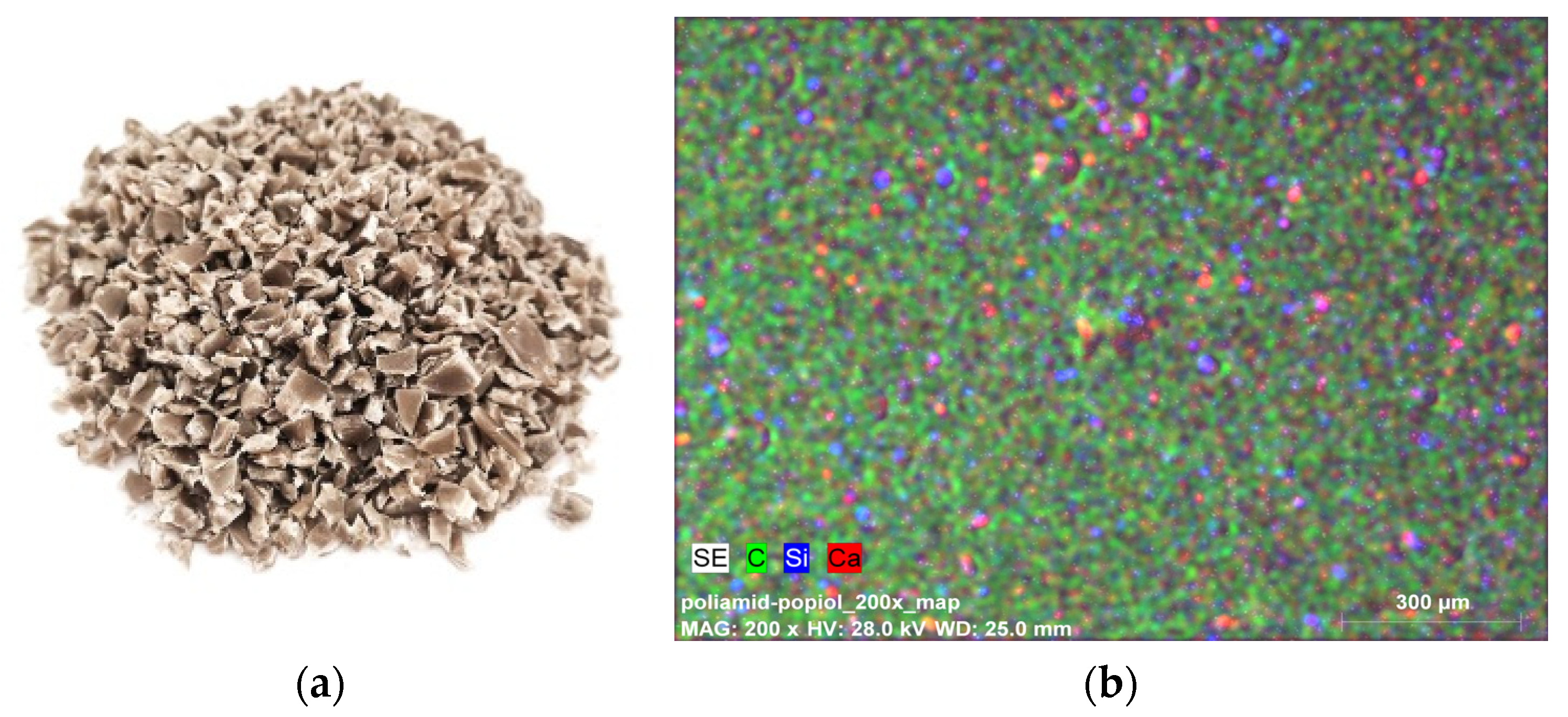
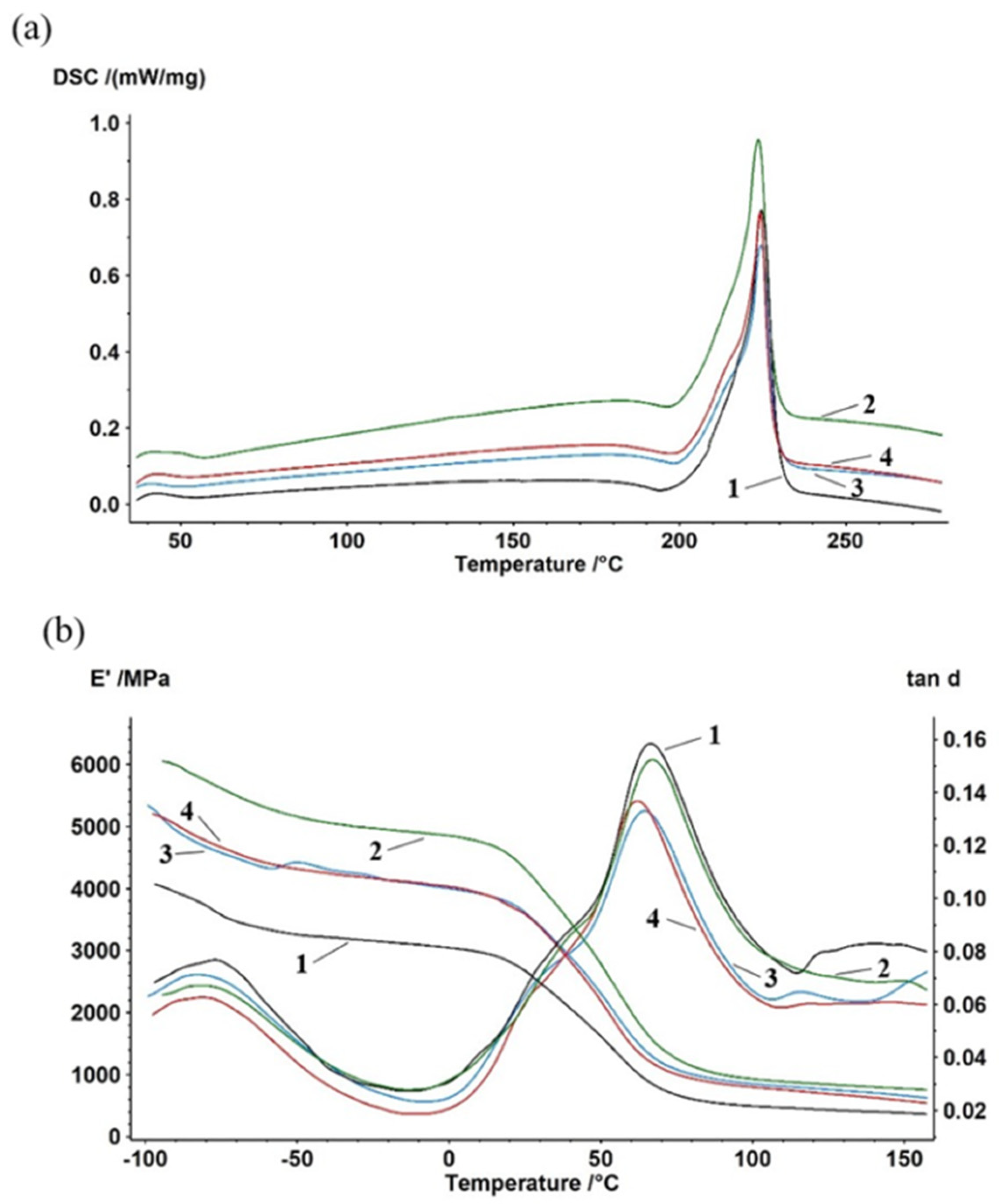
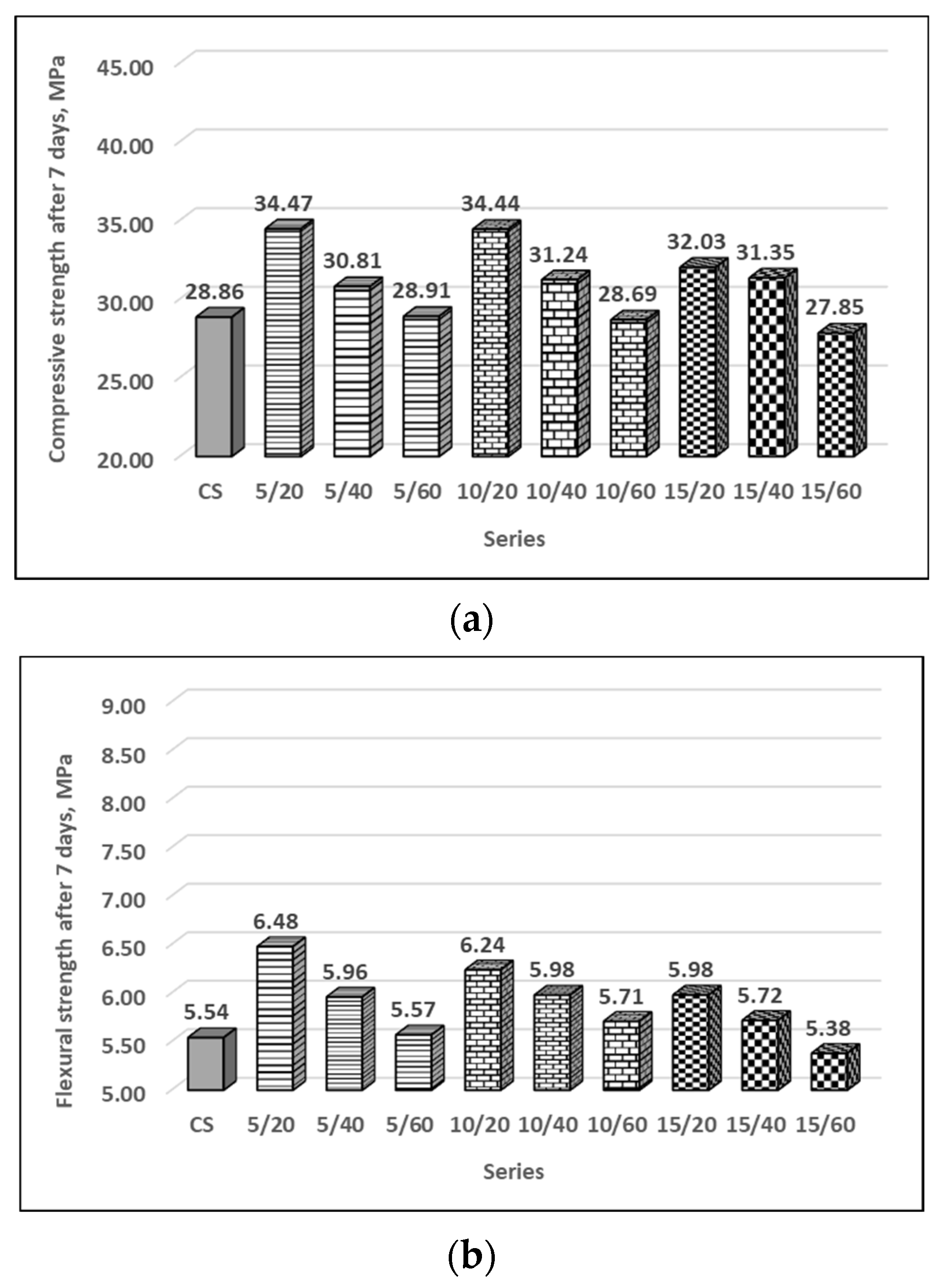

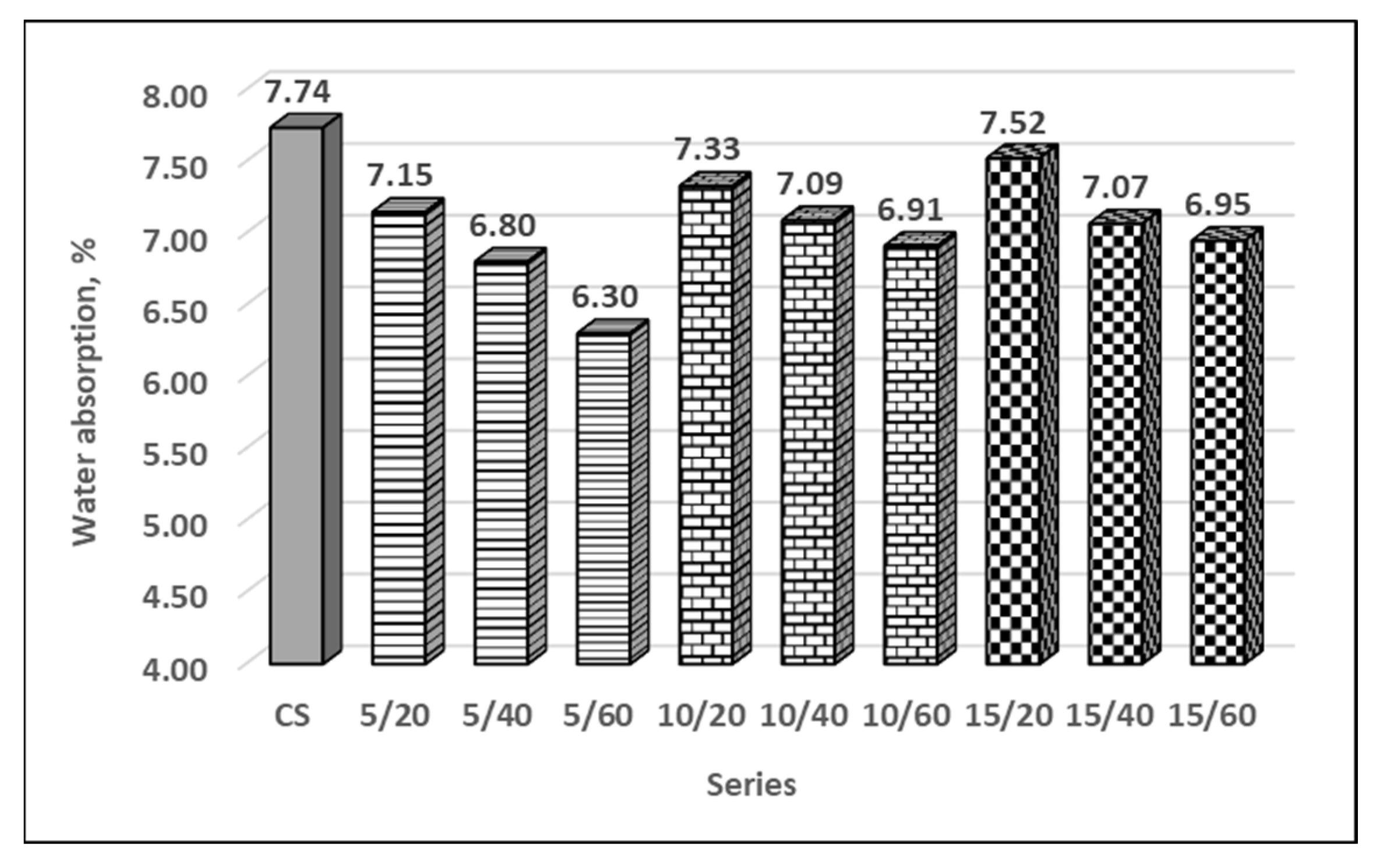
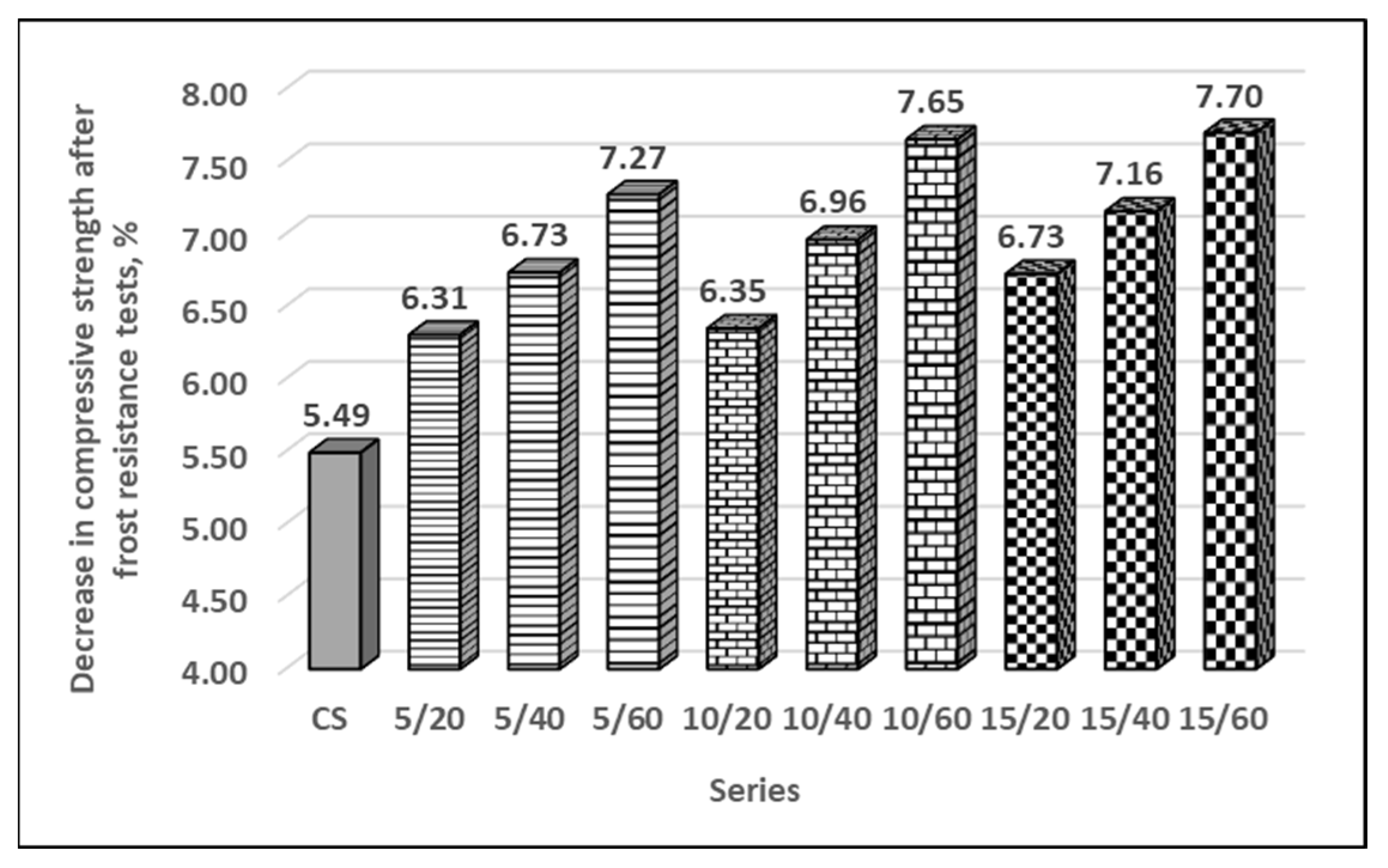

| Type of Material | Melt Temp., [°C] | Melting Range of the Crystalline Polymer Phase, [°C] | Enthalpy of Melting [ΔH, J/g] | Glass Transitions Tg, [°C] | Coefficient of Mechanical Loss Tg D [-] |
|---|---|---|---|---|---|
| PA | 224.5 | 218.9–229.5 | 50.93 | 66.8 | 0.16 |
| PA + 5% fly ash | 223.9 | 218.8–230.1 | 52.26 | 67.1 | 0.15 |
| PA + 10% fly ash | 224.4 | 220.5–228.6 | 41.54 | 64.4 | 0.13 |
| PA + 15% fly ash | 224.1 | 219.1–227.8 | 39.05 | 62.2 | 0.14 |
| Oxide/Element | Content, [%] | Oxide/Element | Content, [%] |
|---|---|---|---|
| SiO2 | 57.54 | MnO | 0.51 |
| CaO | 17.26 | TiO2 | 0.30 |
| K2O | 3.93 | CuO | 0.02 |
| Al2O3 | 4.82 | Cr2O3 | 0.01 |
| MgO | 2.32 | ZnO | 0.06 |
| Fe2O3 | 2.94 | BaO | 0.08 |
| P2O5 | 2.01 | SO3 | 2.71 |
| PbO | 0.02 | Cl− | 1.06 |
| Na2O | 0.39 | Other | 4.02 |
| Series | Cement CEM I, g | Standard Sand, g | Water, cm3 | Polyamide + 5% Fly Ash, g | Polyamide + 10% Fly Ash, g | Polyamide + 15% Fly Ash, g |
|---|---|---|---|---|---|---|
| CS | 450 | 1350 | 225 | - | - | - |
| 5/20 | 450 | 1350 | 225 | 20 | - | - |
| 5/40 | 450 | 1350 | 225 | 40 | - | - |
| 5/60 | 450 | 1350 | 225 | 60 | - | - |
| 10/20 | 450 | 1350 | 225 | - | 20 | - |
| 10/40 | 450 | 1350 | 225 | - | 40 | - |
| 10/60 | 450 | 1350 | 225 | - | 60 | - |
| 15/20 | 450 | 1350 | 225 | - | - | 20 |
| 15/40 | 450 | 1350 | 225 | - | - | 40 |
| 15/60 | 450 | 1350 | 225 | - | - | 60 |
| Metal Ions | Series | Limit Values, mg/dm3 | |||
|---|---|---|---|---|---|
| SC | 15/60 | ||||
| A, mg/kg | s | A, mg/kg | s | ||
| Zn | <0.005 | - | <0.005 | - | 2 |
| Cu | 0.087 | 0.013 | 0.119 | 0.021 | 0.5 |
| Cr | <0.005 | - | <0.005 | - | 0.5 |
| Ba | 0.114 | 0.016 | 0.132 | 0.039 | 2 |
| Pb | 0.096 | 0.014 | 0.116 | 0.017 | 0.5 |
Disclaimer/Publisher’s Note: The statements, opinions and data contained in all publications are solely those of the individual author(s) and contributor(s) and not of MDPI and/or the editor(s). MDPI and/or the editor(s) disclaim responsibility for any injury to people or property resulting from any ideas, methods, instructions or products referred to in the content. |
© 2024 by the authors. Licensee MDPI, Basel, Switzerland. This article is an open access article distributed under the terms and conditions of the Creative Commons Attribution (CC BY) license (https://creativecommons.org/licenses/by/4.0/).
Share and Cite
Ulewicz, M.; Jura, J.; Gnatowski, A. Cement Mortars Based on Polyamide Waste Modified with Fly Ash from Biomass Combustion—A New Material for Sustainable Construction. Sustainability 2024, 16, 3079. https://doi.org/10.3390/su16073079
Ulewicz M, Jura J, Gnatowski A. Cement Mortars Based on Polyamide Waste Modified with Fly Ash from Biomass Combustion—A New Material for Sustainable Construction. Sustainability. 2024; 16(7):3079. https://doi.org/10.3390/su16073079
Chicago/Turabian StyleUlewicz, Malgorzata, Jakub Jura, and Adam Gnatowski. 2024. "Cement Mortars Based on Polyamide Waste Modified with Fly Ash from Biomass Combustion—A New Material for Sustainable Construction" Sustainability 16, no. 7: 3079. https://doi.org/10.3390/su16073079





